2026 Author: Howard Calhoun | [email protected]. Last modified: 2025-01-24 13:10:43
Most modern breeds of pigs are characterized, among other things, by endurance and unpretentiousness. However, such animals can, of course, also get sick from time to time. In most cases, various kinds of ailments in piglets are the result of improper care.
Classification
Diseases in piglets, like any other farm animal, can be mild or severe. Some diseases of piglets are considered incurable and often lead to the death of animals. Other swine diseases resolve within a few days if properly treated.

In any case, all diseases of piglets can be classified into two large groups:
- contagious;
- not contagious.
Pathologies of both of these varieties can cause serious harm to farms.
Contagious diseases
Illnesses of this particular group are often very difficult for piglets and lead to a reduction in the herd. The most common contagious diseases in pigs are:
- ascariasis;
- trichinosis;
- dysentery;
- pasteurellosis;
- edematous disease;
- mug.
A very dangerous infectious disease of such farm animals is, of course, also African swine fever.
Non-communicable diseases
Such ailments usually do not proceed as severely as infectious ones. However, due to such diseases, pigs often lose significantly in productivity, and sometimes die. Non-contagious diseases can be diagnosed in animals of absolutely any breed. Such ailments affect landrace, Lithuanian, Duroc piglets, etc.
Most often, the following pathologies of this group are diagnosed in pigs:
- gastroenteritis;
- peptic ulcer.
Ascariasis: economic loss
This chronic disease is caused in piglets by the roundworm Ascaris suum, which parasitizes the small intestine. The main reason for the development of such an ailment in pigs is non-compliance with sanitary standards in the barn. Pigs become infected with roundworms mainly through feed and water.
Economic damage to the farm, no matter what piglets are bred in it - Duroc breeds, Estonian bacon, Urzhum, etc. - ascariasis can cause significant. Piglets rarely die from this disease. But at the same time, consuming a large amount of feed, infected pigs do not gain weight well. In addition, the meat of piglets with ascariasis is forbidden to be eaten. Unfortunately, people can also become infected with such worms.
Symptomsascariasis
This disease can occur in piglets both in acute and chronic form. Symptoms of ascariasis in both of these cases are the same. The only thing is that in the chronic form, the signs of infection with Ascaris suum will be less pronounced.
You can suspect ascariasis in pigs on the farm if you have the following symptoms:
- cough;
- allergic reaction of unknown origin;
- trembling limbs;
- high body temperature;
- liquid stool;
- sluggishness;
- profuse salivation.
Severe weight loss of the animal is also a sign of chronic ascariasis.
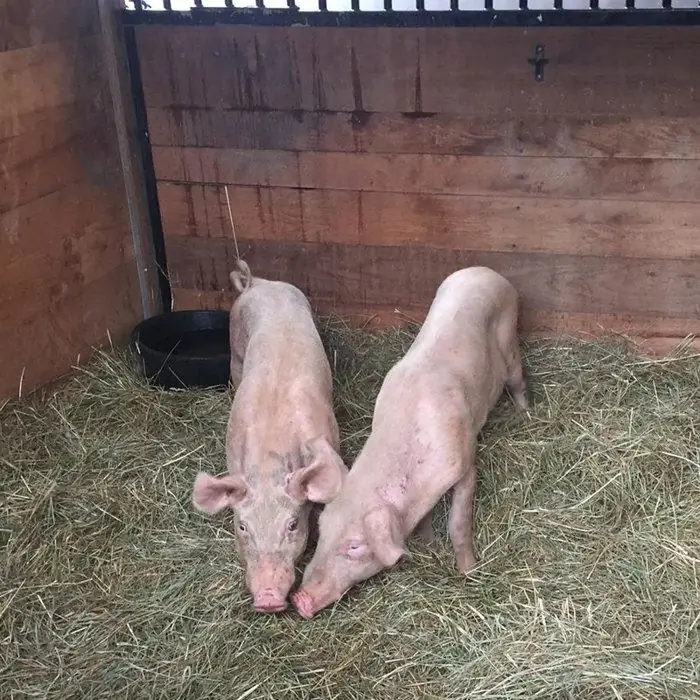
Prevention measures
Piglets under the age of 6 months are most often infected with ascariasis on the farm. It is, of course, necessary to carry out various measures to prevent the development of such a disease for pigs of all ages. However, in this case, young animals should be given maximum attention.
Measures for the prevention of ascariasis in farms usually take the following:
- perform deworming of pigs from other farms;
- twice a year they do preventive deworming of the herd;
- deworming queens 30 days before farrowing.
When carrying out preventive deworming, insecticide treatment of pigsties is also performed at the same time.
Treatmentdiseases
Ascariasis, which has already developed in pigs, is usually fought on farms using modern antiparasitic drugs. Piglets of the Duroc breed, Kalininsky, Breitovsky, Vietnamese, etc. with this disease are usually given:
- "Piperazine S alt". This drug is given to pigs twice a day with feed. The course of treatment in this case is 1 day.
- "Fenbendazole". This medicine is also added to piglets in feed. In this case, a dosage of 10 mg / kg is used. The course of treatment in this case is 1 day.
Such preparations are used for deworming the entire herd at once. Giving antiparasitic drugs to just one animal is, of course, absolutely useless in this case.
Trichinosis: source of infection
This disease also belongs to the group of helminthiases. It is caused by a special type of nematode - Trichinella spiralis - and is dangerous, including for humans. Pigs can become infected with such worms through food, from sick piglets, etc.
Piglets are infected with Landrace, Large White, North Caucasian, etc. trichinosis under the same conditions as ascariasis. This disease can manifest itself in two forms - muscular and intestinal.
Signs of illness
Trichinosis is a disease that can be identified in a piglet by the following symptoms:
- increased muscle temperature;
- severe vomiting;
- swelling in the neck and limbs;
- complexbreath.
Muscle pain is also a sign of trichinosis.
What to do?
You can prevent the development of this disease in pigs by observing sanitary standards on the farm, quarantine of newly purchased piglets, heat treatment of feed, etc. Trichinosis is a disease for which, unfortunately, no treatment has been developed. But still it is believed that Thiabendazole, Mebendazole, Albendazole can help piglets from this disease.
Causes of dysentery
This disease is contagious and usually occurs in pigs in a very acute form. In another way, this disease is called piglet typhus, black diarrhea, etc.
Dysentery is caused by the bacterium Treponema hyodysenteriae. The main reason for the development of this disease is non-compliance with sanitary standards in pigsties. Poor feeding also contributes to the infection with dysentery, which often results in a weakening of the immunity of animals.
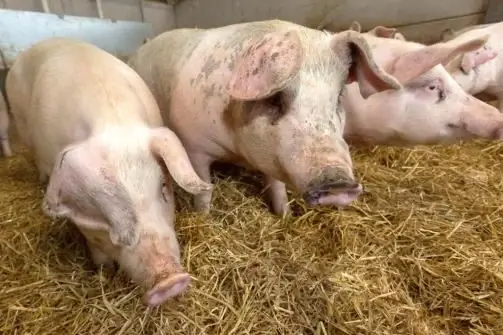
Signs of dysentery
This infectious disease is considered one of the most dangerous for pigs. The mortality rate of suckling and newborn piglets from dysentery, for example, is 100%. The temperature in Treponema hyodysenteriae-infected pigs, as with many other infectious diseases, does not rise. Animals with such a disease do not lose their appetite.
The main sign by which this disease can be identified is loose stools in piglets. Diarrhea appears in pigs usually 1-3 days after the pathogen enters the body.dysentery. The faeces of sick animals first become watery and then turn brown and foul-smelling.
In addition, symptoms of dysentery in pigs are:
- vomit;
- anemic skin;
- hanging tail;
- sunken eyes;
- blue skin;
- discoordination of movements.
Dysentery Prevention
Taking measures to prevent the development of this disease, since it causes truly enormous damage to farms, should, of course, be mandatory. Preventive measures aimed at reducing the risk of dysentery and diarrhea in piglets are usually carried out as follows:
- quarantination of piglets brought from other farms within 30 days;
- preventive disinfection of farms;
- treatment of the skin of pigs with an alkaline solution of formaldehyde.
The danger of dysentery is, among other things, the fact that pigs with this disease practically do not develop immunity. Very often this disease in piglets is repeated. No vaccine has been developed for this disease.
Dysentery treatment
Severely ill pigs with this disease are usually sent for slaughter. The remaining animals are treated with "Osarsol". In order to avoid a recurrence of the disease, piglets are additionally given "Furazolidone".
African swine fever: causes
This formidable disease can be carried(mechanically) rodents, cats, dogs, birds. Of course, pigs can also become infected from sick piglets. Insects are also carriers of this disease - ticks, horseflies, fleas, etc.
Unfortunately, this disease is very dangerous. For example, in the Novgorod region, African swine fever in the summer of 2018 alone claimed the lives of about 37 thousand animals, causing truly colossal harm to farms. This virus has been spreading in Russia since 2007
Signs of African plague
Very often this disease, unfortunately, is asymptomatic. The animal just suddenly dies. Thus, the fulminant form of the disease manifests itself. In acute distemper, piglets show the following symptoms:
- sudden rise in temperature;
- white fetid discharge from ears, eyes and nose;
- hind limb paralysis;
- vomit.
When the disease becomes chronic, pigs experience:
- shortness of breath;
- small cough and fever;
- ulcers and wounds on the skin;
- inflammation of the tendons.
What to do to prevent development
Of course, so that African swine fever in the Novgorod region, Moscow, Novosibirsk, Yekaterinburg and in any other region throughout Russia does not damage the economy, farms should take various preventive measures against it.
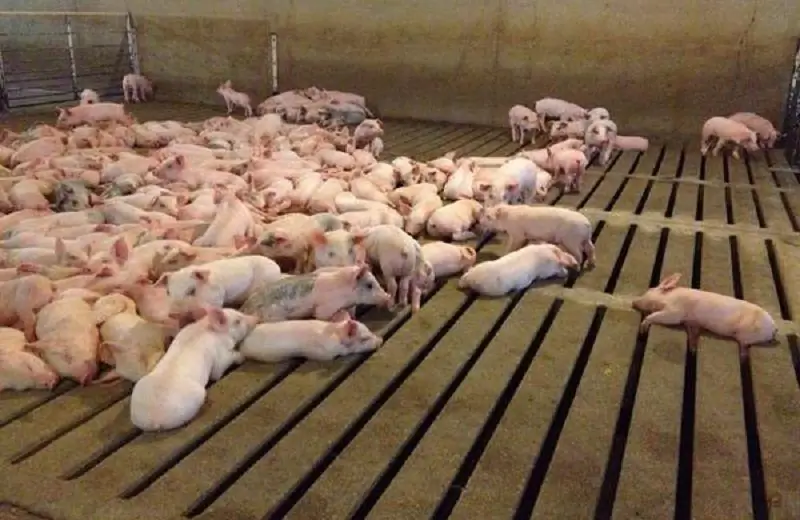
Treatment of this disease todayday, unfortunately, not developed. The farmer can only try to prevent its development in piglets. African swine fever prevention measures include:
- acquisition of animals only with a veterinary certificate;
- quarantine;
- regular disinfection of pigsties.
Edematous disease of pigs
This disease is caused by a special Escherichia coli that can produce B-hemolysin. Most often, edematous disease is observed in small piglets at the age of 1-2 months. The causative agent of this disease multiplies in the intestines of animals.
How to identify: signs
In the fulminant form of this disease, piglets die quickly and without symptoms. The next morning, the owners simply discover the corpse of the animal. But most often, edematous disease in piglets still proceeds in an acute form. In this case, you can determine it by the following symptoms:
- a sharp increase in body temperature;
- swollen eyelids;
- unsteady gait;
- Inadequate response to loud sounds (irritation, seizures).
Ultimately, the pig develops asphyxia, as a result of which he dies.
In the chronic form, edematous disease develops mainly only in adult pigs. It manifests itself in this case as a lack of appetite, a general depressed state.
Edematous disease treatment
To prevent the spread of the disease, all piglets with visible symptoms immediately after their detection are transferred toseparate room. At the same time, infected animals are prescribed a diet for 10-12 hours. At the same time, pigs are given a laxative.
In order to reduce intoxication with edematous disease, piglets are offered magnesium sulfate. At the same time, they constantly monitor that animals always have enough water in the drinkers.
Erysipelas in pigs
This disease in piglets is caused by the bacterium erysipelothrix insidia. Its main carriers are infected pigs, birds and rodents. Flies can also infect pigs by spreading this bacterium mechanically. Pigs usually get sick with erysipelas at the age of 3-12 months. At the same time, this disease develops most often in summer, spring or autumn. In winter, pigs do not get sick with erysipelas. This ailment does not develop in newborn piglets, to whom immunity is transmitted from the mother with milk.
The causes of infection in this case, as in most others, are non-compliance with sanitary standards, poor living conditions for animals, and an unbalanced diet. Very often, the causes of an outbreak are:
- high temperature in the pigsty;
- poor ventilation;
- abrupt change in feeding regimen.
Swine erysipelas: symptoms and treatment
The acute form of this disease in pigs is characterized by the following symptoms:
- sudden rise in temperature;
- oppressed state;
- loss of appetite;
- cardiac weakness;
- feed refusal.
Pigs with acute erysipelas refuse to move, burrow into bedding, pant. At the same time, their skin acquires a bluish color. At the next stage, the disease passes into a subacute form. At the same time, colorless and then dark swellings appear on the body of the pig. With the transition to a chronic form with erysipelas, piglets develop skin necrosis.

It is necessary, of course, to take measures to save animals from this disease, immediately after its symptoms are detected. Treatment of swine erysipelas and its prevention primarily involves the creation of good living conditions for piglets. Also, vaccinations are periodically carried out against this disease in pig farms. It uses a special serum in combination with penicillin antibiotics.
Piglets are vaccinated against erysipelas in farms at the age of 2 months. The vaccine is administered to animals twice with an interval of 14 days. Repeat the procedure in the next 6 months.
Sick pigs on the farms are treated with antibiotics, as well as antipyretic and detoxifying drugs.
Pasteurellosis
This disease in pigs is often diagnosed at the same time as erysipelas. Pasteurellosis in piglets is characterized primarily by blood poisoning by pathogenic microorganisms, as well as inflammation of the intestines and upper respiratory tract. The causative agent of this disease is Pasteurella multicida.
The causes of this disease are usually high humidity inpigsty, hypothermia, crowding. Inadequate feeding can also contribute to the outbreak in the herd.
What are the symptoms
Pasteurellosis is a rather dangerous disease of piglets that requires immediate treatment. And in any case, of course, every farmer should know the symptoms of it. You can identify this disease in pigs by the following signs:
- high temperatures;
- loss of appetite;
- dyspnea;
- general oppression.
When the disease becomes chronic, pigs develop the following symptoms:
- cough;
- swollen joints;
- eczema of the skin.
Sick pigs in the chronic stage, among other things, begin to rapidly lose weight.
Treatment and prevention of pasteurellosis
In order to prevent the development of this disease in pigs, vaccinations are periodically carried out on farms. The premises are also regularly disinfected. Treatment of pasteurellosis is quite effective with the use of antibiotics. Pigs on the farm can be given, for example, "Tetracycline", "Levomycetin", "Terramycin", etc.
Gastroenteritis in pigs: causes
This disease in piglets inflames the stomach and intestines. At the same time, pathological processes are observed immediately in all three layers of the walls of these organs.
This non-contagious disease usually develops in piglets due to poor care practices. Fromwhat they feed the piglets of Vietnamese, Lithuanian whites, Durocs, etc., their well-being and developmental features depend directly. Pigs can get sick with gastroenteritis, for example, if they are offered low-quality, moldy, stale food. Also, such an ailment is often diagnosed in animals due to poisonous herbs and various irritating drugs. In young piglets, this disease often develops due to a sudden transition to dairy-free feeding.
Sometimes this problem in pigs also occurs due to stressful situations. Gastroenteritis in piglets can be diagnosed, for example, after transportation, hypothermia, overheating, etc.

The main symptoms of the disease
A sign of the development of gastroenteritis in a piglet is primarily a violation of the function of the gastrointestinal tract and intestines. The main symptoms of this disease are:
- lack of appetite;
- sluggishness;
- frequent bowel movements;
- fetid feces.
Treatment
When diagnosing gastroenteritis in pigs, first of all, of course, it is necessary to eliminate the cause of its occurrence. That is, low-quality feed should be removed from pig feeders, the possibility of eating poisonous grass should be excluded, etc.
Actually, for the treatment of sick piglets are kept on a starvation diet for 12-24 hours. Further, the animals are transferred to a special light diet. At the same time, pigs are given hay flour, meadow grasses, oatmeal mash, carrots.
From preparationswith gastroenteritis, saline laxatives, sodium chloride solutions with glucose and gastric juice are well helped by piglets. In severe cases of the disease, animals can also be injected intravenously or intraperitoneally with a glucose-s alt solution.
Peptic ulcer
With this disease in pigs, a defective lesion of the mucous membrane and underlying tissues of the stomach is observed. The causes of peptic ulcer in piglets can be:
- prolonged feeding with dry or too finely ground food;
- toxicosis;
- some types of helminthiases.
In some cases, the ulcer in pigs may be perforated.
Symptomatics
Currently, according to statistics, on farms, gastric ulcer develops in 5% of sows and about 60% of nursery pigs. That is, this ailment can be considered very common.
Determining peptic ulcer in pigs is unfortunately usually very difficult. The symptoms of this disease are non-specific. Usually, when there is such a problem, the piglet is observed:
- depression;
- stomach pain;
- loss of appetite;
- weight loss.
Often a sick pig begins to vomit blood. Blood is also found in the feces of an unhe althy animal. With a perforated ulcer in a pig, inflammation of the peritoneum can also be observed.
How the treatment is done
Pigs with peptic ulcers, of course, are supposed to be given only the highest quality feed. lightenthe state of such an animal can be offered by offering him raw eggs, kissels, oatmeal broths, broths. Also give pigs with peptic ulcer:
- vitamins;
- "Papaverine";
- belladonna;
- "No-shpu".
Sick piglets are given weekly injections of iron and multivitamins, among other things.
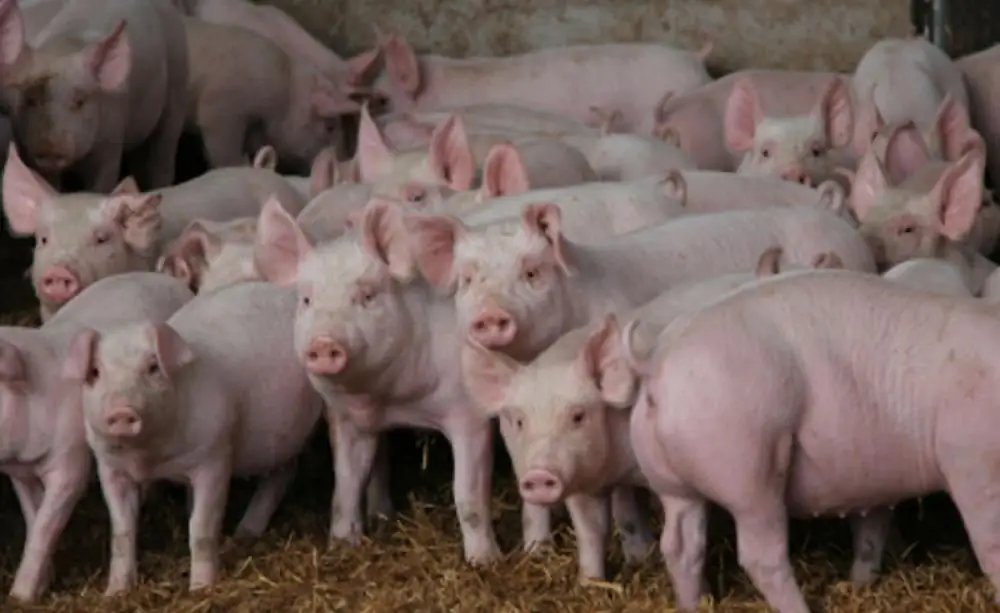
For the prevention and treatment of peptic ulcer, what is fed to Vietnamese, Duroc, large white and any other piglets is of great importance. The diet for sick pigs is designed in such a way that they get enough protein, fiber and vitamin E. They also make sure that the piglets do not include too much feed containing indigestible fats in the menu of pigs. Very suitable for such animals, among other things, a diet based on whey and milk.
Recommended:
How to feed piglets? Rules for growing piglets at home and in a pig farm

How to feed piglets? To implement successful livestock production, it is necessary to pay attention to the principle of nutrition in the conditions of production farms. In this case, two types of food can be considered: dry and wet
Diseases of rabbits: symptoms and their treatment. Disease prevention in rabbits
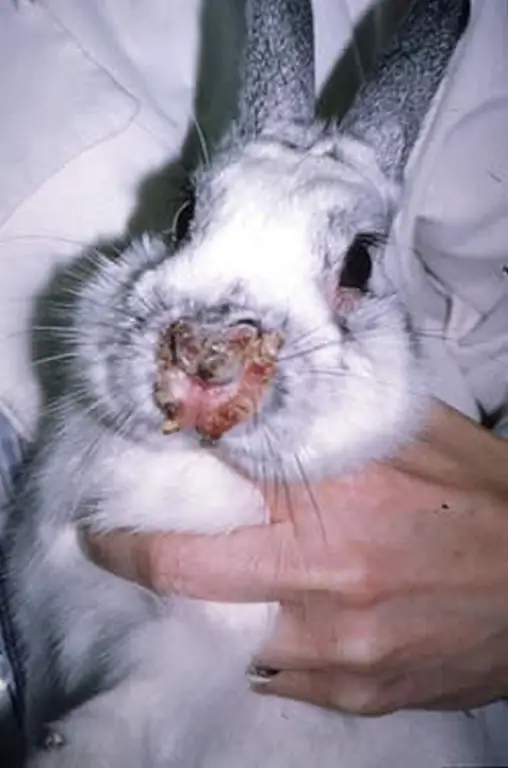
Rabbit diseases can destroy most of the livestock in a matter of days. In order to provide assistance to animals in time, it is necessary to be able to determine the disease, as well as vaccinate in time, follow the rules of care
Sheep diseases: types, causes, symptoms and treatment

Know what diseases are in sheep, should all breeders involved in the breeding of these mammals. Recently, the popularity of sheep breeding has increased, as the benefits of such an activity have become obvious. True, an inexperienced person, without paying enough attention to the prevention and treatment of diseases, can easily be left without all the livestock at once. To prevent this from happening, you need to know what are contagious and what are non-contagious diseases of sheep, how you can prevent them, how you can cure them
Swine diseases: symptoms and treatment

Pigs are hardy and unpretentious animals. Farmers who breed piglets usually make a very good profit. However, sometimes he alth problems arise, of course, in these animals. Distinguish diseases of pigs non-contagious, infectious and parasitic
The most common bird diseases: description, symptoms, treatment and prevention
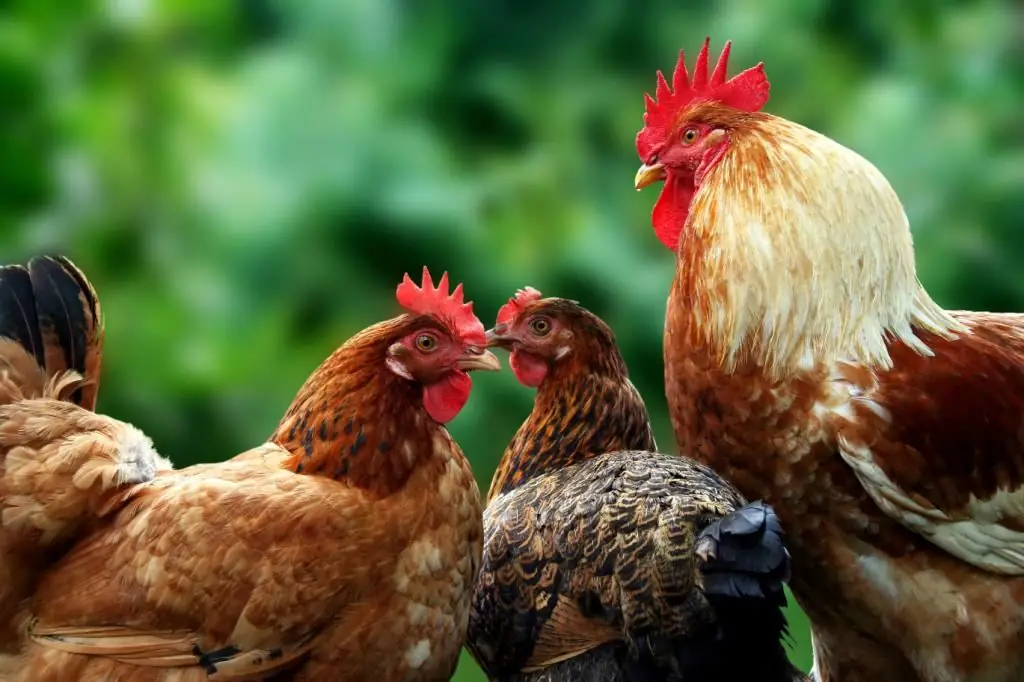
Farming poultry is not only profitable, but also affordable. With proper housekeeping, you can not only provide your family with meat and eggs, but also earn decent money. However, as in every business, there are pitfalls, and here they are. The main problem in poultry breeding are diseases that, in the absence of adequate treatment and preventive measures, can cause serious damage to the farm

